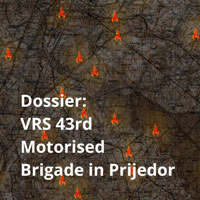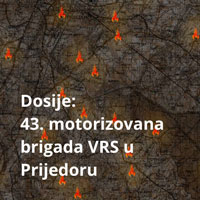Dossier: VRS 43rd Motorised Brigade in Prijedor
 Between May and August 1992, units of the 1st Krajina Corps of the Army of the Republika Srpska (VRS), together with the police of the Republika Srpska, Territorial Defence Force (TO) units and various volunteer groups, carried out attacks on a large number villages in the municipality of Prijedor inhabited predominantly by Bosniaks and Croats.
Between May and August 1992, units of the 1st Krajina Corps of the Army of the Republika Srpska (VRS), together with the police of the Republika Srpska, Territorial Defence Force (TO) units and various volunteer groups, carried out attacks on a large number villages in the municipality of Prijedor inhabited predominantly by Bosniaks and Croats.
In the documents of the VRS and the Ministry of the Interior (MUP) of the Republika Srpska, combat operations in the Prijedor municipality were referred to as “cleansing operations” and actions aimed to crush extremist groups. However, as established in several judgments of the International Criminal Tribunal for the former Yugoslavia (ICTY), these operations involved the systematic killings, abuses, arrests and detention of non-Serbs, as well as the destruction and looting of their property.
More than 3,000 civilians died in the territory of Prijedor municipality in 1992, and around 38,000 Bosniaks and Croats left the municipality before the second half of October of 1992.
18 individuals (in 11 cases) have been finally convicted by the ICTY for crimes committed on the territory of Prijedor municipality during the war in Bosnia and Herzegovina, including almost the entire Republika Srpska leadership headed by Radovan Karadžić, Biljana Plavšić and Momčilo Krajišnik, several members of the police, security commanders and guard shift commanders at prison camps in Prijedor, as well as members of local and regional authorities.
In November 2017, the ICTY Trial Chamber handed down its judgment in the case of Ratko Mladić, former Commander of the Main Staff of the Army of Republika Srpska, sentencing him to life imprisonment. Mladić was, among other things, convicted of the crimes of persecution, extermination, murder, deportation and forcible transfer of people in municipalities across BiH, including Prijedor. It should be noted that Ratko Mladić is the only senior VRS officer to be convicted of crimes committed in Prijedor.
To date, none of the commanders of the 1st Krajina Corps brigades that took part in operations in Prijedor, including the 43rd Motorised Brigade (43rd MtBr) of the Army of Republika Srpska, have been held to account either in Serbia or in BiH for crimes committed in Prijedor, despite the fact that the commander and deputy commander of the 43rd MtBr – Vladimir Arsić and Major Radmilo Zeljaja respectively – were indicated as co-perpetrators in the ICTY trial judgement in the case of Milomir Stakić.
This Dossier aims to make public information about the circumstances of crimes committed in the course of the 1992 military operations in Prijedor, and the available information and evidence concerning the role and responsibility of the units of the 1st Krajina Corps of the VRS, most particularly the 43rd MtBr, for crimes committed in this municipality, as well as the actions of officers and the VRS commands they reported to following these crimes.
The first part of the Dossier is concerned with the establishment of the Army of the Republika Srpska in May 1992, its corps and units, and the structure of the 43rd MtBr and other units of the VRS 1st KK that were deployed in Prijedor. Also, it presents the political context of the events in Prijedor and provides an overview of the political decisions made at the republic and local levels that set the direction for the VRS during the armed conflict in BiH.
Attacks by Serb forces on villages in Prijedor are analysed in the second part of the Dossier. The attacks largely followed the same pattern. First, Serb forces would issue an ultimatum calling on residents of non-Serb villages to surrender their weapons, after which the villages were shelled, regardless of whether or not the ultimatum was complied with. After the shelling, members of the military and police units would enter the villages and abuse, kill, or capture local non-Serb residents and take them to prison camps, which was followed by looting and torching of the villages.
The third part of the Dossier examines the role of the 43rd MtBr in the operation of the prison camps in the Prijedor area, and in the cover-up of crimes.
The fourth and last part of the Dossier is dedicated to the accolades and decorations that the commanders and units that participated in operations in Prijedor received during the war and their post-war activities.
The Dossier: VRS 43rd Motorised Brigade in Prijedor







